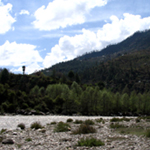
Jewellery
The female figurines in the pahare nuntire are depicted with adornment on their body, suggestive of the antiquity of this craft of Pahare, Jewellery. The urge to adorn on self with ornaments remains conditioned by this social other of the community- their beliefs, customs and manners- their economy means and the inborn sense of beauty worn on festive occasions in this valley BORANWALA CHAK has pendants suspended towards the neck.
KIRTISKI, variation of chak with inner surface lined with gold is worn by the tribal women.
SHANGLI
Is a head band worn along the side of the head with the one end attached it the head dress and other to the place. Placed a little above the ears a pair of PHUL ( flowers ) made of sliver constitute a popular price of ornament at marriage. The SHINGAR PATTI appears as silver band for the forehead. KARN PHOOL is an ear top made of silver. KANTEY are the ear rings or ear pendants made of gold or silver.
BALLI
Is a simple ear ring; made a gold and silver with two beads in the in the centure with a small turquoise or with imitation pearls, the TILLI is a miniature top. DHAOTU and MUNGRI are distinctive process of ear decorations. The Nose ornament NATH is the most important of all ornaments.
BESAR
Is also long nose ring. LAUNG is an elaborate and large sized nose stud, made of gold. TILLI or KOKA is a small nose stud, with a capped fixing device. Among the neck ornaments, KATHI, SINGI, HAAR, DODMALA, HARMALA CHAMPAKALI, HANSLI or TANDRI, MUTIG KANTI are famous & popular. The wrest ornaments are GAJRU, CHURA, CHURIS KANGAN, CHHAL-KANGAN, CHALBALE, for finger, the women use angoothi, guthi and CHAAP- the rings made of gold and silver.
CHALLER POLDIAN
Are the ornaments of the toe. For the anklets there is a thin chain, the PAZEB. The TORA is a pazeb with a clasp while the ZHANJAR is an anklet with pendants.
Gudma
Gudma made from the wool of the grangi sheep is fleecy soft blankets. Includes in this range are thobis (floor coverings) and Karcha (mattresses).
Cuisine
Valley's different climatic conditions and geography regions and their varied produce have given a range of dishes that are special to each area. In most areas there is pastoral traditions, milk and milk products are used liberally in cooking. The meals are generally centered on meat, lentils and cereals. Recently green vegetables have become a part of man vegetarian components of Valley's cuisine in region of higher attitude. The spics commonly used are cardamom, cinnamon, claves and red chilies.
A popular dish of this valley
SIDV is made of wheat dough to which milk yeast is added. This is allowed to ferment for 4-5 hours. With a stuffing of fat, it is first browned over a lower flame and their steamed. These cakes are normally eaten with ghee, lentils or mutton.
The Musical Instruments
Among the wind instrument commonly found in this valley are Turhi (bugle), bishudi (flute), algoza (atwin flute) Shehani or peepni. The percussion instruments forming the basic rhythm of folk music is dhol along with nagaras, dafale and tamaka.
Antiphonic instruments
Used as accompaniment to the vocal and instrumental music are jhanjh ( large cymbals), manijru (Small cymbals), chimta (tongs), thali (platter), ghanta (gengs) etc.

- HOME
- Pabbar Valley
- Our NGO
- Charitable Tours
- Why Charitable Tours
- Shimla Town Adventures By [ KPYM NGO ]
- Around Shimla
- Shimla Manali Tour
- Kinnour Tour
- Kinnour Lahaul Spiti Tour
- Shimla Pabbar Valley Rishikesh
- Himachal Tour
- Religious Tour
- Ladakh & Kashmir Tour
- Jammu Kashmir,Vaishno Tour
- Buran Pass
- Rupin Trek
- Bhaba Pass Trek
- Churdhar Peak Trek
- Charitable Tours Gallery
- Contact


